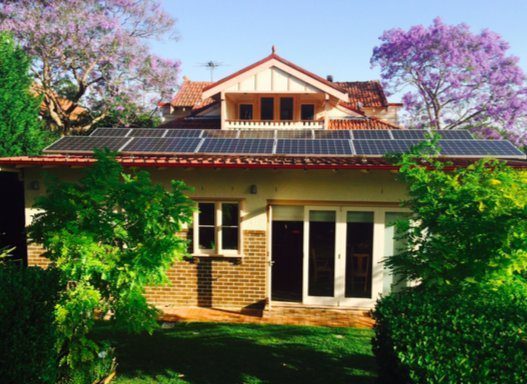
Solar pioneer David Mills says if he can do it, almost anyone can. And by doing “it”, he means powering his suburban house and his two electric vehicles largely through rooftop solar, and storing excess output in battery storage.
For the last two years, Mills has been been working on integrating solar PV with battery storage, a hot water system and two EVs – a Tesla Model S85 and a BMW i3 – all in a conventional grid-connected home.
And, he admits, it is not a particularly energy efficient home, or even very well placed for solar. His home is angled about 45°C from the north, and one of his two solar arrays is shaded by trees, particularly in winter.
The house – built in 1921 – has no special seals, window coatings or double glazing. In other words, it is not particularly energy efficient. And it is not exactly low usage either. Apart from the demands of the EVs, there are five adults and three of them are young “profligate” users of electricity.
But here is his cheerful and re-assuring message, particularly for the many people in the suburbs looking at how they can reduce their soaring electricity bills. “If our home can do it, then any home can do it.”
 Mills estimates that if solar PV was being installed today, then almost 2/3 of the energy could be supplied for this house and the two EVs. Were the site less shaded by trees, it had better insulation, and if higher quality solar PV panels were included, then solar could provide a lot more.
Mills estimates that if solar PV was being installed today, then almost 2/3 of the energy could be supplied for this house and the two EVs. Were the site less shaded by trees, it had better insulation, and if higher quality solar PV panels were included, then solar could provide a lot more.
“The impact of storage is also likely to be significant,” he says.
“It can almost eliminate peak and shoulder period imports on many days, even in rainy and cloudy weather if the storage draws from the grid during off-peak periods. Such storage should make the grid more stable, especially in hot weather as experienced in eastern Australia in February.”
So, how has he done it?
First thing is, the gas supply has been removed, so the house runs almost purely from electricity (there is a wood fireplace).
He has an evacuated tube “solarhart” hot water system that he actually helped design with a colleague in the late 1990s. Bizarrely, the equipment was not sold Australia, but in Germany for a number of years. It shoulders the majority of hot water needs but is backed up by PV and grid electricity.
 The house has 7.43kW of rooftop solar, half of it in a conventional array on the back of the house, with 16 230watt panels installed in 2010, and half in a specialised designed “pocket” in the centre, with 250W panels installed in 2015.
The house has 7.43kW of rooftop solar, half of it in a conventional array on the back of the house, with 16 230watt panels installed in 2010, and half in a specialised designed “pocket” in the centre, with 250W panels installed in 2015.
And it has two of the first edition Tesla Powerwalls. One sits on each of two phases (in NSW you must have three phases installed with a solar array higher than 5kW, although no one has been able to explain why – it is just a rule). The third phase is used to charge the two EVs at night from off-peak.
The Tesla Powerwalls both have a rating of 6.4kWh. Mills installed them just days before the unveiling of the twice- -as-powerful-but-pretty-much-the-same-price Powerwall 2.
He is a bit rueful about that but he likes the original design. The earlier version has no back up for outages, although the folk at battery inverter company SMA say they are working on an upgrade for that.
So, how has it all gone?
The first thing is how cheap the EVs are to run. Yes, they are very expensive to buy, but that cost will fall as more models are made available in Australia and the costs of battery storage fall.
His Tesla was one of the first batch to be delivered in December 2014, and since then it has done some 36,000km – at an overall average of 5km/kWh, or 5.5km/kWh on the highway. His model has a range of up to 400km.
Over the year that means, he is doing 14,265kms and using 2,925kWh to power it. range.
It is mostly charged at night on off-peak rate through the 7kW Tesla wall charger at 11.7c/kWh. At that price the weekly “fuel” bill is around $6.58, but as it turns out some of its provided by free Tesla supercharging. And Mills sometimes uses excess solar on summer days to charge it.
The BMW i3, bought a year later, has done just 6,547km at overall 7km/kWh. It has lower range than the Tesla, but is fine for Sydney and just makes it to their weekender in Leura. Annual “fuel” consumption – based on 4,333km – is about 605kWh, or a weekly fuel cost of $1.36.
It, too, can use domestic PV more easily if dialled down to its minimum 8 amp draw, and Mills can’t speak highly enough of the EVs – safe, stable, fast and fun to drive.
And how has the overall system performed? We need to turn to the graph for that, and it needs a little explaining.

The colour scheme is as follows: reddish orange on the left is energy drawn from the grid, purple is storage discharging to house loads, light orange is charging of storage from either solar or off peak, yellow is solar export to grid, and green is solar used to meet house loads.
On this day (and many others), storage and direct solar combined to almost eliminate imports from grid during the shoulder and peak periods between 7AM and 10 PM,” Mills says.
The system consumed a net of 26.3kWh, and all but 6kWh of it was delivered through solar and storage. And almost all the grid power was imported at the off-peak rate.
Had there been vehicle charging that day, it would have been through off-peak at night, but the system feeds substantial excess solar to the grid in summer to partially compensate for that.
In NSW, the new IPART recommended solar feed-in tariff rates for 2017 will mean the FIT is about the same rate as off-peak, so Mills says the grid will then act like a “zero cost, long term solar electricity storage system” for off-peak loads.
“This shows that wide adoption of rooftop PV with EVs can achieve very substantial emissions reduction in both the domestic and transport sectors,” Mills says. “At the same time, a lot of grid usage is diverted away from peak to the off-peak times, helping to flatten grid costs and increase stability.”
“Low-priced 270W panels are available today at about $3500 for 5.4 kW installed with an inverter, and 320 W standard size panels at higher prices will be available this year.” And even more powerful panels, 360W, expected in 2018, might run a house like ours and two cars 87 per cent of the time.
“I think we are underestimating what’s going to happen with rooftop solar, and with storage,” Mills says, and adds. “My wife says we can’t go back to the internal combustion engine.” So, that’s decided then.
This article was originally published on RenewEconomy’s sister site, One Step Off The Grid, which focuses on customer experience with distributed generation. To sign up to One Step’s free weekly newsletter, please click here.








